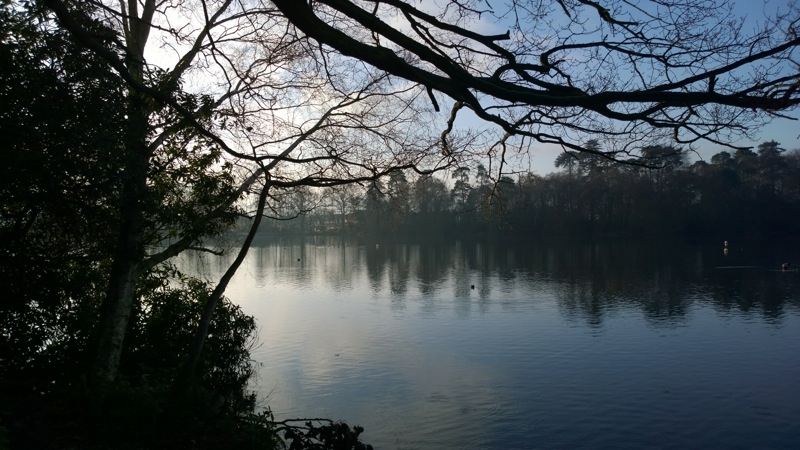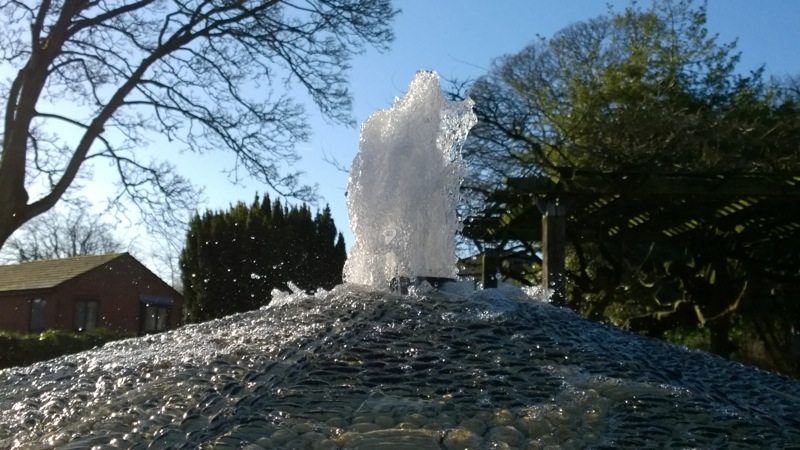[Stirring words from me, yes. And yes, I'm including even the older Nokia 808 PureView in the generalisation - the 808 has a few use cases where it's still superior, but the 1020 is now very close behind it in each - and there are also many situations where the 1020 is better. Plus the 1020 produces better video capture, is higher specified, is an actively sold product and is far more future proof.]
Why the new set of photos, why the excitement?
Black.
The new OS update for the Lumia 1020 (and all other Windows Phones) includes a whole new set of oversampling and image processing algorithms, interpreting the mass of data coming from the 1020's enormous 1/1.5" (see below) 41MP sensor in new, 'purer' and more accurate ways. And it has got me excited, as you'll be able to tell from the commentary below.

(From Nokia's Juha in his Engadget interview at CES 2014) From left to right, a front-facing camera, an 'entry level' camera (probably 1/4", but not a million miles from the camera size used in most other smartphones of today), the Lumia 1520's 1/2.5" camera and finally, on the right, the Lumia 1020's 1/1.5" unit, positively dwarfing the rest.
Unusually (for me), this feature doesn't take the form of a 'device vs device' head to head, but instead I wanted to include real world photos under a variety of conditions and then look very closely, with 1:1 crops, to look at the level of noise, of purity, and so on....
All photos are also taken on full 'auto' on the Lumia 1020, apart from the one shot where I mention otherwise. In other words, there's no special voodoo magic or special expertise going on here, there are shots that represent what the man in the street can do with his 1020.
Test photo 1: Sunny lake
Here's the overall scene, click to enlarge the photo in your browser further or, more usefully, to download it for your own analysis:
Pretty impressive, though in fairness most decent camera phones will get this shot right. Let's be impressed by the detail and general purity of the image at a 1:1 crop from near the centre, though:
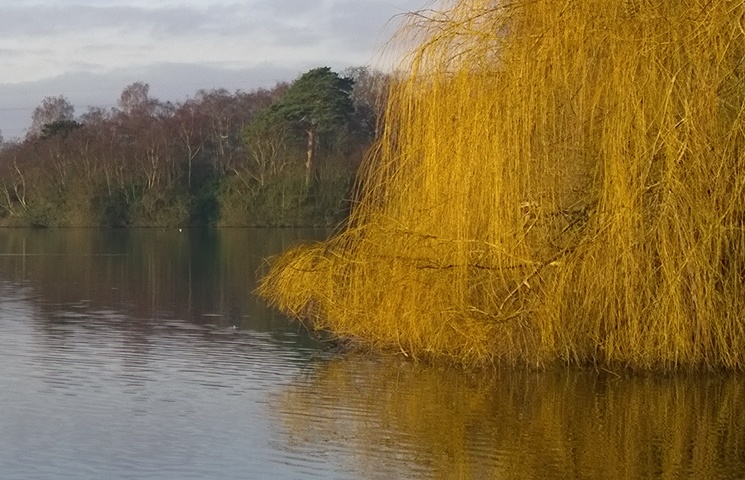
The challenge, for any digital camera, is to balance the image processing such that sufficient detail is pulled from the Bayer filtered image data without sharpening the image so much that fine texture becomes obscured by artefacts. With Lumia Black, Nokia has gotten the balance spot on for the 1020, as you can see here. Wonderful detail and hardly an artefact in sight.
Test photo 2: Moody(!) lake
The same lake, but from a very different angle, shooting into the light and with lovely tree and water detail... Here's the overall scene, click to enlarge the photo in your browser further or, more usefully, to download it for your own analysis:
With no leaves on the tree, there's tremendous detail here in terms of the finer twigs, plus there's the big challenge of automatically getting a nice balance for the lighting - the 1020 succeeds on both counts. Here's a 1:1 crop from near the centre:
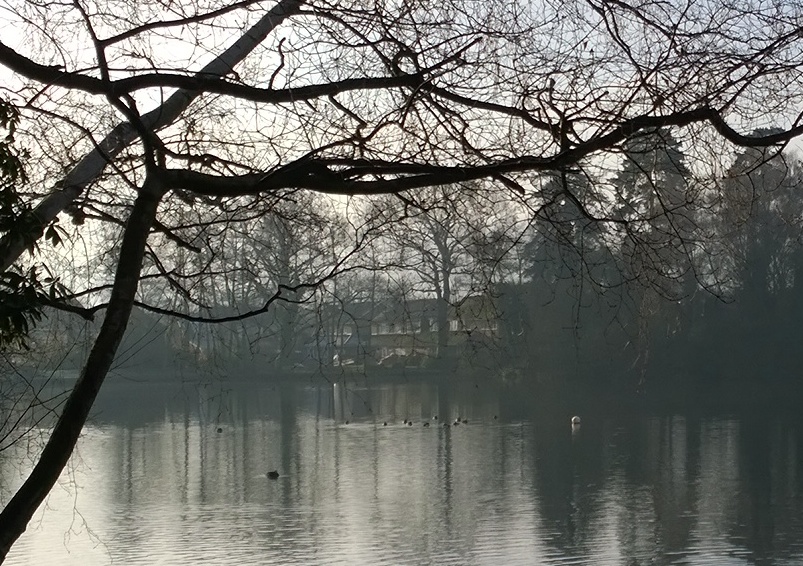
Again a very respectable rendering of the mass of twigs in the tree, the whole photo is finely balanced - and again I'd remind you that everything was set on full auto - no effort or expertise was needed to get this shot.
Test photo 3: Very bright midday sun, blue sky and tree detail
A clear winter's day and bright sunlight provided another good test scenario. Here's the overall scene, click to enlarge the photo in your browser further or, more usefully, to download it for your own analysis:
Again with no leaves on the tree, there's tremendous detail here, plus a flawless blue sky to capture. Here's a 1:1 crop from near the centre:

OK, OK, enough with the twigs, I get it. Have a look at areas of sky in the photo though, and you'll be impressed by the lack of artefacts - most camera phones snap a blue sky and you end up with patterns that come from the low grade sensor and/or over-sharpening. With Black on the 1020, the detail, colour and texture is all just right.
Test photo 4: Freezing motion in the sun: Fountain
One of the main things you can fiddle with in Nokia Camera is shutter speed, so I had a go at freezing this fountain, shot against the sun, by using the shortest shutter speed I could. Here's the overall scene, click to enlarge the photo in your browser further or, more usefully, to download it for your own analysis:
Terrific stuff. Here's a 1:1 crop from near the centre:
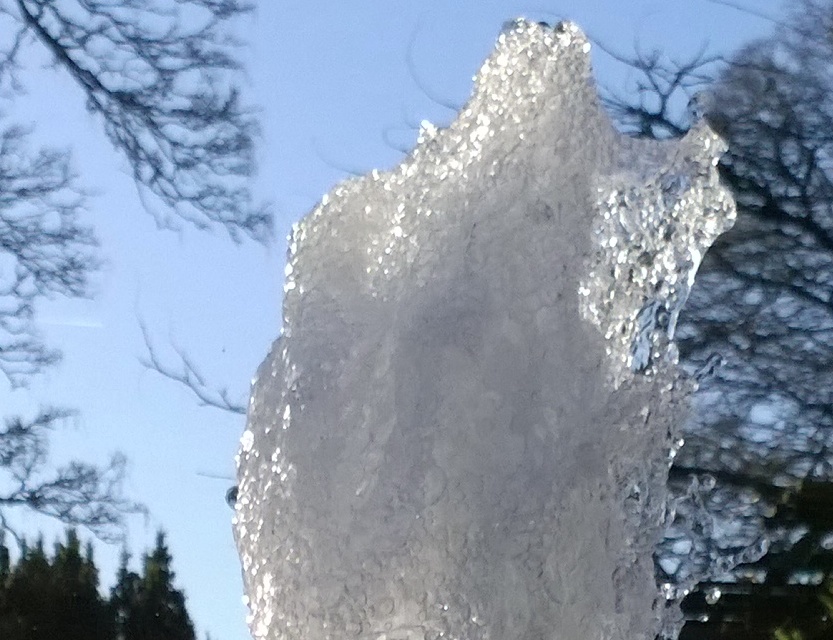
Actually focussing on the ever-moving water wasn't trivial, but the 1020 did a decent job, with striking water detail here - it could almost be ice! Being able to adjust shutter speed from 1/16000s to 4s means that, with water especially, you can get any effect you care to dream up.
Test photo 5: PureView zoom and purity
I couldn't resist another subject with detail shot against a flawlessly rendered blue sky, in this case zoomed in slightly using the lossless PureView zoom as well. Here's the overall scene, click to enlarge the photo in your browser further or, more usefully, to download it for your own analysis:
So much detail in the tower, and so much purity in the sky behind it. Here's a 1:1 crop from near the centre:

I was impressed by purity and detail again, but also by the auto-exposure, whcih stayed just short of over-exposing the sunny face of the tower in order to deliver detail on the shady face. It's looking more and more like it's impossible to take a bad photo with the Lumia 1020/Black combination!
Test photo 6: Indoors, shop lighting, shelf detail
Shot from around 6 metres away, this is a good test of the OIS and PureView oversampling. Here's the overall scene, click to enlarge the photo in your browser further or, more usefully, to download it for your own analysis:
Impressive again, considering the lighting. Here's a 1:1 crop from near the centre:

The range here would have been too much for Xenon flash to make much of a difference, so I shot without it. The OIS kept the camera in the 1020 perfectly still here, even though it was just a casual shot, handheld, in low ambient light. I don't think many standalone cameras would have achieved as good a result.
I should also emphasise that, if I'd wanted to see fine detail on a subject at this range, I could have used the PureView zoom or used the 'full resolution' version of the photo - but this feature is about shareable 'real world' snaps.
Test 7: Posed subject, flash used
One of the achilles heels of the Nokia Amber image processing was a slight yellow tint to flash-illuminated photos, but Black seems to have sorted this out. Here's a posed subject of a small relative, blurred to protect her privacy but left framed so that you can see where the crop is coming from:

And here's a crop from the photo, magnified so that we can look at the 'purity' of the pixels:

Even magnified, there are no artefacts, nothing ugly in the processing. The Black update even seems to keep 'red eye' to a minimum, with just an attractive 'glint' in pupils to indicate that the Xenon flash was fired.
Test 8: Fast moving subject, flash used
No, not a pub shot mock-up from yours truly, but a real world shot of a different small relative. Two years old and never staying still ever - no concept of striking a pose, and the only way to photograph her reliably is with Xenon flash, as on the Lumia 1020. Again I've blurred her face to protect her privacy, but you'll get the idea:

It's this sort of shot which means that, once you've used a camera phone with Xenon flash (in my case, starting with the Nokia N82, back in 2007) you can't really go back. In this sort of indoor situation with kids, you could take a hundred photos with an iPhone or Samsung Galaxy and every one would be blurred. Or you could take just one with Xenon and get something you can share instantly around the whole family - crystal clear.
With Black in place, Xenon-lit shots are even more foolproof - there's no yellow tint, there's perfect exposure and even red eye seems to be rare. I'm very impressed.
Test photo 9: Dark of night
Finally, my standard 'dead of night' shot, with street lights the only source of illumination. Here's the overall scene, click to enlarge the photo in your browser further or, more usefully, to download it for your own analysis:
Astonishingly crisp, as we're used to seeing now from Nokia's OIS-equipped camera phones. Here's a 1:1 crop from near the centre:

There's the usual complaint that the scene isn't really as dark as was perceived by my eyes, but there's really little that's wrong here - there's a very slight grain/noise, but get this into perspective - there was very little light around. Moreover, the OIS again worked well - despite a third of a second exposure time, there's only a very tiny bit of blur from me shooting this at head height, by hand. And remember that this is an extreme case - most real world night subjects will be better lit (fountains, buildings, posed people, etc.)
Perfection: achieved. Next?
I had high hopes for the Black firmware update for the Lumia 1020, with the new oversampling algorithms, and I wasn't disappointed. The gold standard for oversampling is the Nokia 808's hardware processing of the 41MP sensor data and, with this update, the Lumia 1020 matches what the 808 achieves in terms of reducing noise and creating 'purer' pixels. It's true that the software-based approach here is still a lot slower - shot to shot times on the 1020 are still over three seconds - but the important thing is that the 'PureView' vision is fully realised on Windows Phone with this update.
In fact, in terms of image quality, I'd declare the Lumia 1020 with Black to be nigh on 'perfect', and you'd hopefully agree, given the images above? Aside from faster shot to shot times (achieveable perhaps with a 1020 successor in 2014 with four times the chipset speed?), there's almost nothing that can be improved on here.
Of course, having declared the 1020 to be 'perfect', there's the other 99.9% of smartphones (sold) to be considered, most of which fall horribly short when trying such a wide set of test shots as used here. So, across the industry, there's clearly a long, long way to go. But at least we have a new gold standard, a new benchmark.
And, as with the 808 PureView before it, I suspect the only way the Lumia 1020 will now be topped for photo quality will be by the introduction of its own successor.


